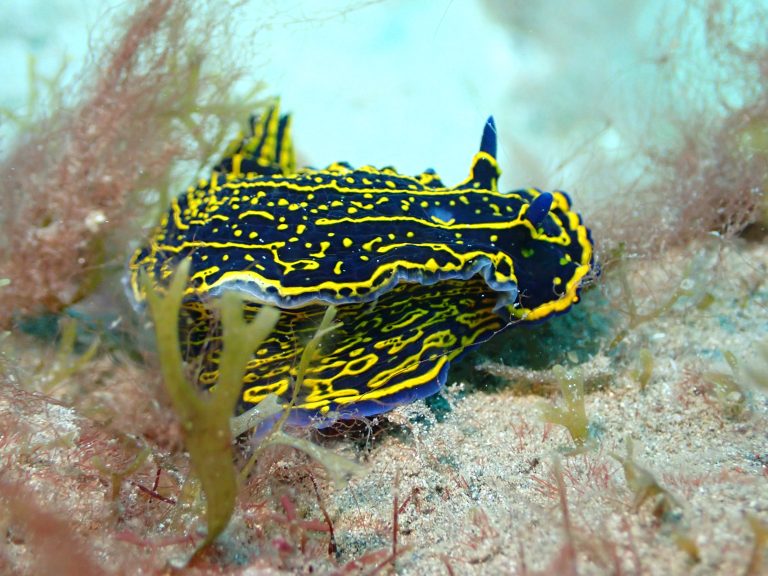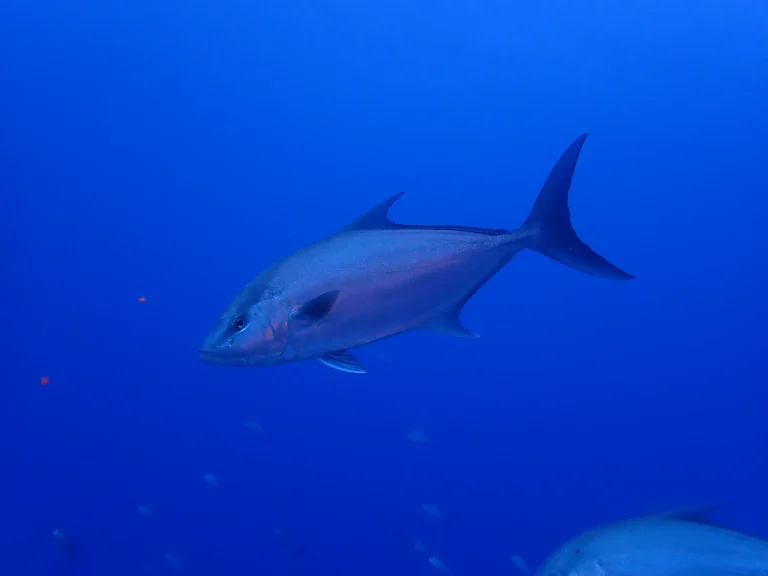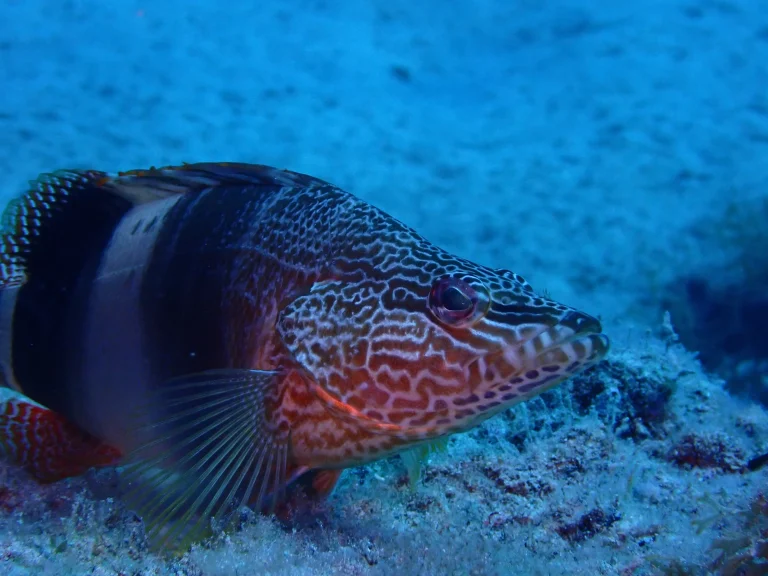Our dive sites
Fuerteventura may not be a place with hundreds of different dive sites, nontheless, it does offer beautiful and plentiful marine life for Atlantic Ocean conditions. Each dive site is unique in its flora and fauna. Our experienced dive team will take you to these spots to see what you can discover in the bottom of Fuerteventuras ocean, doesn’t matter if you are a certified diver or a complete beginner, there are dive sites for every level.
Prepare to be amazed!
Big Reef(el veril grande)
The underwater structure shows a plateau at 15m depth with mainly sandy bottom and shallow rocky formations, which descends over a steep wall to 40m water depth. The total length of the reef is about 250m. The descent is made after a short snorkeling stretch from the beach or directly from a zodiac boat. Along a rope line you reach the famous moray eel reef at 15m depth. Under the protection of the rock formations you can find all kinds of small creatures. Among the permanent reef inhabitants are numerous free-swimming large and small moray eels, which have given the reef its name. Parrotfish, trumpetfish, damsels, breams and the shy garden eels can be seen there daily. Large schools of sardines attract tuna and amberjacks. Majestically, hundreds of barracudas move over the reef, and the hand-tamed groupers await the diver as he descends. Frequent encounters include large and small rays, squid, as well as the harmless angel sharks and conger eels. Rare encounters with moon fish, manta rays, dolphins and whale sharks occur. Colorful sponges, sea anemones and cylinder roses complete the picture.



SMALL REEF (EL VERIL PEQUEÑO)
The underwater structure shows a sloping sandy bottom at a depth of 12m, which transitions to rocky terraced substrate at a depth of 22m, then drops off over a steep wall to 35m water depth. The total length of this reef is about 200m and still growing after every storm. The descent is also made here after a short snorkeling stretch from the beach or directly from a zodiac boat. On the sandy bottom you will discover the nimble sea squirts, plaice, garden eels and lizard fish lurking for prey. Under small ledges, crevices and caves linger the smaller beauties: Cylinder roses, sea anemones and sponges. Free swimming moray eels are a common sight. At the reef edge you regularly encounter a number of medium sized groupers, and small schools of sardines are greedily held at bay by single barracudas before they attack predatorily. In the different depths you will often find butterfly rays and marble tremor rays burried in the sand, which glide majestically away when they feel disturbed by divers. Even though the small reef is not as rich in fauns as the big reef in the immediate vicinity, it is still worth several dives.



El Chupadero (el puertito)
The underwater structure consists of a rocky bottom down to a depth of 10m, transitioning into a sandy area partially covered with sea grass. The diving area, which runs almost endlessly parallel to the cliff, is well suited for beginner, check and night dives. The descent takes place immediately or after a short snorkeling stretch from the sandy beach within a protected bay. Already at 4m water depth you reach the rocky-sandy bottom. After leaving the bay, you will come across many large, free-standing or connected rock formations, which give this diving area an interesting, adventurous character. In small and large rock crevices not only small fish but also other creatures find their shelter. Besides colorful club anemones, starfish and sponges, you can find nudibranchs, cuttlefish, octopus, cleaner shrimp, sea spiders and parrotfish. Boxfish, starfish and the rare snake eel, an immigrant from the Caribbean, as well as larger scorpionfish have also settled here. In a cave that can be dived without danger you can find rays, shy groupers and moray eels. Harmless angel sharks, barracudas in small groups as well as trigger fish are not seen as often at this dive site as at the big and small reefs, nevertheless they do occur.



Las Salinas
Day trip with two dives The diving areas at the old salt mines near the village of Caleta de Fuste are impressive because of their visibility. Here you will not find a sandy bottom but extensive rock formations. A nice diving spot, but a bit far. So two dives are organized here with a surface break and a small snack in between. Las Salinas is considered a highlight for advanced divers. A rough rugged rocky landscape with steep drop-offs, large overhangs and tunnels, as well as red and black coral. Often big fish like tunas, barracudas, rays and sharks are seen here. Diving depths between 25 and 40 meters



FISH TOWER
This dive can be done in combination with a day trip to Salinas, since they’re very close to each other. After a jump in the ocean from a lava formation that goes in the water, we start our descent into a very rocky bottom, which is home for many smaller fish and especially fish that like to hide between the rocks. This dive is characterized by an algae that is white and swims free which gives it a very fluffy feeling. It’s also good for people with less experience since the dive is between 5 and 15m, the only tricky thing is the entry and especially the exit, but nothing unobtainable for a motivated diver.



AJUY
This dive is a very special one but only reachable under very special conditions since it is located in the West coast of the island, where calm surface water aren’t found daily, and you have to have low tide to be able to go in. When we have the special occasion of going here, we will be taking experienced divers who you know are able to do the dive. This dive takes about 60 min at depths around 15m to 20m. The dive is a shore dive that will very quickly descend into a cave that is around 7m deep and around 5m long. Trust us, you will feel very special things in this dive, even though it may not be the dive with the most flora and fauna, it is a dive with very special landscapes. Hopefully, you are one of the lucky ones who gets to do this one!



Harbour wall
One of the easiest but nicest dives we have on the island. This dive is reachable by a short boat drive just around the harbour wall, as its name suggests so. Jumping in the water from the zodiac boat we start our descent along the rope of the buoy. After that, the direction of the dive will be decided depending on the current that day, if there is any at all. This dive is very rich specially in fauna; we may find big schools of smaller fish, sting rays, trumpetfish, shy groupers, angel sharks, schools of barracudas, morays, anemones amongst many other fish. It’s a very simple dive since we stay mostly at 10-12m deep, barely adjusting our BCD’s and less air consumption for a nice and long dive.
Canyon/Anemone Field:
This dive is a riddle under water. This rocky labyrinth is only reachable by boat around 5 minutes away from the harbour in Morro Jable. Once we dock at the buoy, we start our descent at the rope to around 15m, which will be our predominant depth. This dive is very special in its flora since it is filled with very small purple anemones, but also its fauna may vary from other dives including the canarian lobster and if you search long enough under the stones, you may find a big and funny puffer fish, amongst many other types of fish. This dive is suitable for any level of diver and is very one-of-a-kind, so don’t miss the chance to go!



